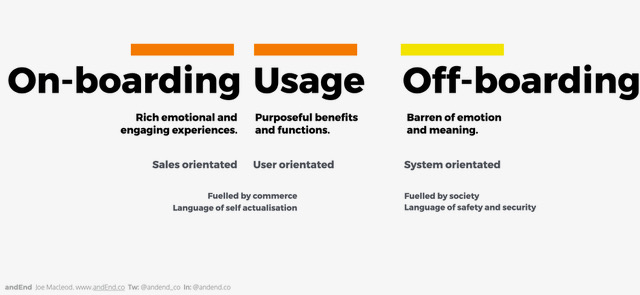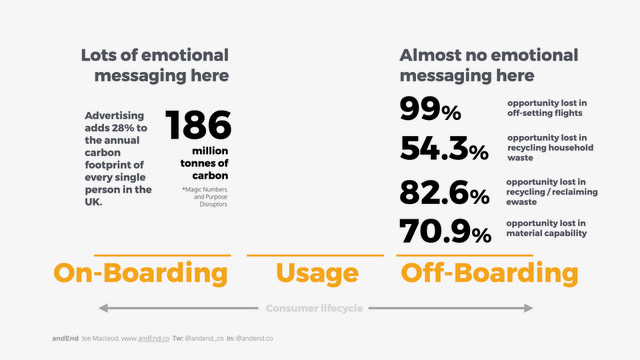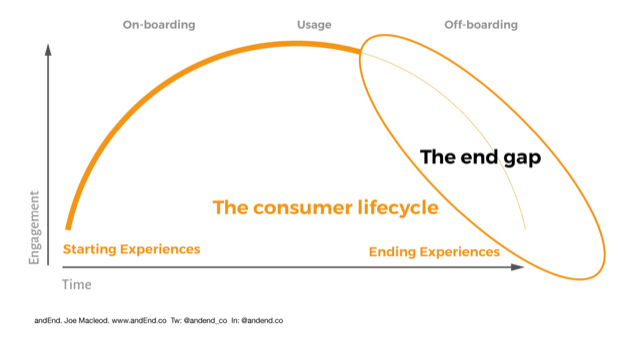Don’t cry, get emotional at the end. Start Endineering
By Joe Macleod, AndEnd
We can break the consumer experience in to three sections – On-boarding, Usage, and Off-boarding. At the beginning of the consumer lifecycle (on-boarding), people experience emotional and engaging messages that attract and inspire them. As they take further interest, marketing gets more detailed and specific to their own personal needs inspiring a purchase.
Once committed the consumer experiences a well-designed and crafted user experience (usage). That product has been tested and iterated to be perfect for the user and their needs.
However, at the end (off-boarding) the story changes. The messages become less emotional, more functional. The messengers become authoritative.

The difference between the on-boarding, usage, and the off-boarding is stark when we consider it in terms of emotional engagement. Traditional business culture would argue why should we care about the consumers emotions when they are leaving. We have already lost their business. I would argue that by not offering a good ending you lose far more than one person’s business.
Bad endings
A poorly designed consumer off-boarding experience can impact your business far more than the loss of a sale. It reduces emotional engagement, it erodes brand equity, it undermines sustainability and circular economy strategies, it leaves a business blind to risk, not to mention how much opportunity there is when creating better endings. Let’s look at these in more detail.
Emotional engagement
Consumerism is driven by desire. It is emotional wants over practical needs. Because of this, humans have created amazing emotional persuasion tools to help encourage the purchase of things we often don’t need. Advertising and marketing have done an incredible job at this. This success equates to sales. But we can also now map advertising directly to climate impact thanks to a recent study.
According to research published at COP in 2021 by Magic Numbers[1], a data analytics firm, and the Purpose Disruptors[2], a network of advertising insiders working on climate issues “Advertising adds 28% to the annual carbon footprint of every single person in the UK. Or 186m tonnes of greenhouse gases, equivalent to running 47 coal-fired power plants all year round.”
Advertising is the emotional encouragement that makes us want to purchase at the beginning of the consumer lifecycle. We use this same argument to measure the lack of emotional engagement at the end of the consumer lifecycle. Highlighting the missed opportunity of emotional endings. Many environmental strategies are having less traction than desired. Could this be because of not engaging the consumer emotionally at the end?
99% of passengers don’t off-set their flights.
According to International Air Transport Association (IATA) “just 1% of passengers offset their carbon emissions through voluntary programmes.” This is despite widespread availability, legal governance, and the mechanisms to deliver the offset. Why don’t more than 1 in 100 people off-set their flights?[3]
54.3% don’t recycle
According to the BBC “The recycling rate for UK households' waste was 45.7% in 2017.”[4] A small increase on the previous year. Yet, recycling has been available for decades. Everyone is familiar with its process and its importance. It has established logistical routes. All the mechanisms are in place. Yet it still has atrociously low levels of take up.
82.6% of ewaste doesn’t get reclaimed
According to the United Nations “17.4 percent of the 53.6 million tonnes of global ewaste in 2019 was collected and recycled.”[5] Yet many nations have clear legislation around ewaste disposal. Lots of businesses talk about the importance of circularity in their business. Yet engagement is worryingly low.
70.9% doesn’t get recycled
According to Coca Cola, they “introduced recyclable 2 litre, polyethylene terephthalate (PET) plastic bottles in 1978.”[6] Which isn’t long after I was born in 1972. I am now 50, and shocked to think that despite having the material capability for nearly half a century, very little of that capability is being used. Just 29.1 percent in 2018 (910,000 tons) was recycled in the US according to the Environmental Protection Agency.[7]

All these systems aiming to improve consumerism, reduce pollution, increase capture rates fail to see the importance of emotional engagement. Each of the systems have all the available logistical, legal, and service infrastructure in place. Yet, fail to gain engagement with the consumer at the end of the consumer lifecycle because they lack emotional engagement. We need to design endings with emotions.

The ends gap
From the work I have been doing over the last decade around endings in the consumer lifecycle - researching and publishing the books, working with businesses and organisations, I have observed common characteristics that establish a wide range of problems in consumerism. I call this the ends gap.
This gap happens between the consumer’s regular usage of the product and its end or demise. At the end engagement of the consumer with their product fades, activities lessen, interest wanes.
This gap has four commonly observed characteristics. Jointly, they generate a vacuum of meaning and purpose in the consumer experience, which limits any improvement or positive action at the end of the consumer lifecycle. This has the potential for laying the foundation for many, wider, critical ills in consumerism.
- The relationship breaks
At the beginning the provider and the consumer are bonded closely in relationship with joint responsibilities. But at the end this breaks apart and with it the materials of that relationship fall to the feet of society or the environment.
- Asset definition is lost
At the begging of the consumer lifecycle definition of a product is clear. Consumers understand detail, capability, and function of a product intimately. But at the end, when a product is placed in the waste or recycling stream its definition is reduced to a fraction. For example, a ‘portable, Bluetooth speaker with surround sound’ is reduced to another piece of e-waste.

- Actors and actions are anonymised
The consumer identity is celebrated at the beginning of the consumer lifecycle. In fact, some of the oldest laws established in societies are around ownership. At the end of the consumer lifecycle, identity is relinquished along with the impact made.
- Routes to neutralising is blurred
When a person consumes a piece of fruit, they can be confident that the peel and pips will naturally breakdown in the environment. A human made product, for example a plastic bag will raise questions about how it breaks down. How it will be neutralised. It will bring up many questions the consumer won’t be certain about the answers. As complexity of the product increases, for example a pen, more questions will emerge.
These four areas, present in the end gap, help identify the problem space that we deal with in consumer experiences and endings.
Towards Endineering
Often overlooked by a traditional business culture that says endings are bad to a business. In many of the engagements I have with businesses, it isn’t that endings are bad or good. It is that endings are avoided. They will certainly happen to all your customers for one reason or another. There is a cultural fear embedded into many businesses about the end. This creates a paralysis for many businesses to apply any innovation or new thinking about the consumer off-boarding of their product.
When I work with businesses, the first thing I try to work on is the business culture about endings. Moving company perception from “avoid” too “strategic opportunity” is critical. I then start providing tools and methods for the businesses to maximise their opportunity.
So, next time you are thinking of methods to improve logistics, increase efficiencies and maximise uptake, look at the emotional gaps. Get the consumer more engaged. Start innovating at the end. Start Endineering at the end.
[1] https://magicnumbers.co.uk/
[2] https://www.purposedisruptors.org/
[3] https://www.theguardian.com/travel/2019/aug/02/offsetting-carbon-emissions-how-to-travel-options
[4] https://www.bbc.com/news/science-environment-49827945
[5] https://ewastemonitor.info/gem-2020/
[6] https://www.coca-colacompany.com/
[7] https://www.epa.gov/facts-and-figures-about-materials-waste-and-recycling/containers-and-packaging-product-specific
AndEnd Website
http://www.andend.co/
Ends Book (2017)
https://www.amazon.co.uk/dp/9163936445
Endineering Book (2021)
https://www.andend.co/endineeringbook
https://www.amazon.com/dp/9163947838/
Become an Endineer
http://www.andend.co/training-for-beginners-in-ends
Join the Endineering Cohort
https://www.andend.co/cohort
LinkedIn
https://www.linkedin.com/in/josephmacleod/
https://www.linkedin.com/company/andend/
Twitter
@mrmacleod
@andend_co
Instagram
@mrmacleod
@andend.co
1 https://youtu.be/3gD7MREWgMI
2 https://www.wired.com/story/startups-prepare-for-downfall/
3 https://www.ifixit.com/News/48850/if-you-want-to-feel-better-about-e-waste-you-have-to-sell-stuff
4 https://www.andend.co/endineeringbook
 Joe Macleod
Joe MacleodJoe Macleod is founder of the world’s first customer ending business. A veteran of product development industry with decades of experience across service, digital and product sectors. Head of Endineering at AndEnd. TEDx Speaker.[1] Wired says “An energetic Englishman, Macleod advises companies on how to game out their endgames. Every product faces a cycle of endings, from breakage to customer burnout to falling behind consumption trends. It's important to plan for each of them. Not all companies do."[2] He is author of the Ends book, that iFixIt[3] called “the best book about consumer e-waste”. And the new book – Endineering, that people are saying “defines and maps out a whole new sub-discipline of study.”[4] The DoLectures consider the Endineering book one of the best business books of 2022.